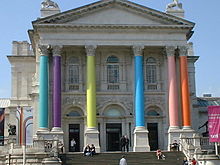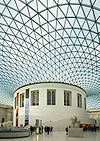- Tate Britain
-
Coordinates: 51°29′27″N 0°07′38″W / 51.490833°N 0.127222°W
Tate Britain 
Established 1897 as National Gallery of British Art; became Tate Britain in 2000 Location Millbank, London, England Visitor figures 1,501,837 (2009)[1]
Director Penelope Curtis[2] Public transit access Pimlico Website www.tate.org.uk/britain Tate Tate Britain · Tate Liverpool · Tate Modern · Tate St Ives Tate Britain is an art gallery situated on Millbank in London, and part of the Tate gallery network in Britain, with Tate Modern, Tate Liverpool and Tate St Ives. It is the oldest gallery in the network, opening in 1897. It houses a substantial collection of the works of J. M. W. Turner.
Contents
History
It is housed in the Tate's original premises on Millbank on the site of Millbank Prison. The front part of the building was designed by Sidney R. J. Smith with a classical portico and dome behind. Construction, undertaken by Higgs and Hill,[3] commenced in 1893. The gallery opened on 21 July 1897 as the National Gallery of British Art, but became commonly known as the Tate Gallery, after its founder Sir Henry Tate. There have been several extensions over the years. The central sculpture gallery was designed by John Russell Pope.
Clore Gallery housing works by J. M. W. Turner
Crises during its existence include flood damage to work from the River Thames and bomb damage during World War II, though most of the collection was in safe storage elsewhere, and a large Stanley Spencer painting, deemed too big to move, had a protective brick wall built in front of it.
The gallery housed and displayed both British and Modern collections, but was renamed "Tate Britain" in March 2000, before the launch of Tate Modern, since which time it has been dedicated to the display of historical and contemporary British art only.
Tate Britain includes the Clore Gallery of 1987, designed by James Stirling, which houses work by J. M. W. Turner.
Facilities
Millbank Millennium Pier outside Tate Britain, which is linked by a high-speed boat to Tate Modern.
The front entrance is accessible by steps. A side entrance at a lower level has a ramp for wheelchair access. The gallery provides a restaurant and a cafe, as well as a Friends room, open only to members of the Tate. This membership is open to the public on payment of an annual subscription. As well as administration offices the building complex houses the Prints and Drawings Rooms (in the Clore galleries),[4] as well as the Library[5] and Archive[6] in the Hyman Kreitman Reading Rooms.[7] The restaurant features a mural by Rex Whistler.
Tate Britain and Tate Modern are now connected by a high speed boat along the River Thames, which runs from Millbank Millennium Pier immediately outside Tate Britain. The boat is decorated with spots, based on paintings of similar appearance by Damien Hirst. The lighting artwork incorporated in the pier's structure is by Angela Bulloch.[8]
Shows
The main display spaces show the permanent collection of historic British art, as well as contemporary work. It has rooms dedicated to works by one artist, such as: Tracey Emin, John Latham, Douglas Gordon, Sam Taylor-Wood, Marcus Gheeraerts II, though these, like the rest of the collection, are subject to rotation.
The gallery also organises career retrospectives of British artists and temporary major exhibitions of British Art. Every three years the gallery stages a Triennial exhibition in which a guest curator provides an overview of contemporary British Art. The 2003 Tate Triennial was called Days Like These.[9] Art Now is a small changing show of a contemporary artist's work in a dedicated room.
Tate Britain hosts the annual and usually controversial Turner Prize exhibition, featuring four artists under the age of fifty, selected by a jury chaired by the director of Tate Britain. This is spread out over the year with the four nominees announced in May, the show of their work opened in October and the prize itself given in December. Each stage of the prize generates media coverage, and there have also been a number of demonstrations against the prize, notably since 2000 an annual picket by Stuckist artists.
Tate Britain has attempted to reach out to a different and younger audience with Late at Tate Britain on the first Friday of every month, with half-price admission to exhibitions, live music and performance art.[10] Other public involvement has included the display of visitors', as opposed to curators', interpretation of certain artworks.
Permanent collection
Tate Britain is the national gallery of British art from 1500 to the present day. As such, it is the most comprehensive collection of its kind in the world (only the Yale Center for British Art can claim similar expansiveness, but with less depth). More recent artists include David Hockney, Peter Blake and Francis Bacon. Works in the permanent Tate collection, which may be on display at Tate Britain include:
- The Painter and his Pug by William Hogarth
- Newton by William Blake
- Horse Attacked by a Lion by George Stubbs
- Giovanna Baccelli by Thomas Gainsborough
- Sketch for Hadleigh Castle by John Constable
- The Great Day of His Wrath by John Martin
- The Lady of Shalott by John William Waterhouse
- Ophelia by John Everett Millais
- The Death of Chatterton by Henry Wallis
- Beata Beatrix by Dante Gabriel Rossetti
- The Golden Bough by J. M. W. Turner
- The Merry-Go-Round by Mark Gertler
- The Resurrection, Cookham by Stanley Spencer
- Norham Castle, Sunrise by J.M.W. Turner
- Three Studies for Figures at the Base of a Crucifixion by Francis Bacon
- Three Ladies Adorning a Term of Hymen by Joshua Reynolds
- The Cholmondeley Ladies by unknown 17th-century artist
- The Mud Bath by David Bomberg
- Recumbent Figure by Henry Moore
- Nocturne: Blue and Gold - Old Battersea Bridge by James McNeill Whistler
The Tate collection is supported by BP.[11] Recently, Tate Britain has unveiled a £45 million ($70.16 million) gallery makeover scheme designed by London-based practice Caruso St John Architects. [12]
Statue of Millais
When the Pre-Raphaelite painter and President of the Royal Academy, John Everett Millais, died in 1896, the Prince of Wales (later to become King Edward VII) chaired a memorial committee, which commissioned a statue of the artist.[13] This was installed at the front of the gallery in the garden on the east side in 1905. On 23 November that year, the Pall Mall Gazette called it "a breezy statue, representing the man in the characteristic attitude in which we all knew him".[13]
In 1953, Tate Director, Sir Norman Reid, attempted to have it replaced by Rodin's John the Baptist, and in 1962 again proposed its removal, calling its presence "positively harmful". His efforts were frustrated by the statue's owner, the Ministry of Works. Ownership was transferred from the Ministry to English Heritage in 1996, and by them in turn to the Tate.[13] In 2000 the statue was removed to the rear of the building.[13]
Transport connections
Service Station/Stop Lines/Routes served Distance
from Tate BritainLondon Buses 
Tate Britain 
87 London Underground 
Pimlico 
0.4 mile walk[14] National Rail 
Vauxhall South West Trains 0.5 mile walk[15] London River Services 
Millbank Millennium Pier 
Tate to Tate 0.2 mile walk[16] Notes and references
- ^ "VISITS MADE IN 2009 TO VISITOR ATTRACTIONS IN MEMBERSHIP WITH ALVA". Association of Leading Visitor Attractions. http://www.alva.org.uk/visitor_statistics/. Retrieved 21 May 2010.
- ^ Press Release: New Director of Tate Britain Appointed, Tate online, 11 November 2009. Retrieved 11 February 2010.
- ^ 'General introduction', Survey of London: volume 26: Lambeth: Southern area (1956), pp. 1-17. Date accessed: 27 March 2010.
- ^ "Prints and Drawings Rooms". Tate. http://www.tate.org.uk/research/researchservices/printrooms/. Retrieved 15 August 2010.
- ^ "Research services: library", Tate online.
- ^ "Research services:archive", Tate online.
- ^ "Research services: Hyman Kreitman Reading Rooms", Tate online.
- ^ "Millbank Pier web site". Millbankpier.co.uk. 22 May 2003. http://www.millbankpier.co.uk. Retrieved 15 August 2010.
- ^ "Days Like These", Tate online.
- ^ "events education", Tate online.
- ^ Press Association (28 June 2010). "Tate Britain party picketed in protest against BP sponsorship | Art and design". The Guardian (UK). http://www.guardian.co.uk/artanddesign/2010/jun/28/tate-britain-party-picketed-protest-bp-sponsorship. Retrieved 15 August 2010.
- ^ WIDN News (06 December 2010). "Tate Britain unveils gallery makeover scheme". The WIDN News (UK). http://www.worldinteriordesignnetwork.com/news/tate_britain_unveils_gallery_makeover_scheme_101206/. Retrieved 06 December 2010.
- ^ a b c d Birchall, Heather. "Sir Thomas Brock 1847-1922", Tate online, February 2002. Retrieved 5 April 2008.
- ^ "Walking directions to '''Tate Britain''' from '''Pimlico tube station'''". Maps.google.co.uk. 1 January 1970. http://maps.google.co.uk/maps?f=d&source=s_d&saddr=Pimlico+Station,+London+Underground+Ltd.,+Bessborough+St,+London,+SW1V+2JA+(Pimlico)&daddr=Millbank,+London,+Westminster,+SW1P+4+(Tate+Britain+Shop)&geocode=FaqpEQMdi_X9_yHP3NN8F9wHwQ%3BFd6vEQMdchD-_yF2izZU1XCeDQ&gl=uk&hl=en&mra=ls&dirflg=w&sll=51.489655,-0.130185&sspn=0.006707,0.013797&ie=UTF8&z=16. Retrieved 15 August 2010.
- ^ "Walking directions to '''Tate Britain''' from '''Vauxhall station'''". Maps.google.co.uk. http://maps.google.co.uk/maps?f=d&source=s_d&saddr=Vauxhall+%4051.485733,-0.123749&daddr=Millbank,+London,+SW1P+(Tate+Britain+Gallery)&geocode=FSWcEQMdmxz-_w%3BCceFvZpyqPh5FS-wEQMdNA_-_yGhMZNfLW4H-Q&gl=uk&hl=en&mra=pe&mrcr=0&dirflg=w&sll=51.488612,-0.126579&sspn=0.006707,0.013797&ie=UTF8&ll=51.488238,-0.1263&spn=0.006707,0.013797&z=16. Retrieved 15 August 2010.
- ^ "Walking directions to '''Tate Britain''' from '''Millbank Millenium Pier'''". Maps.google.co.uk. http://maps.google.co.uk/maps?f=d&source=s_d&saddr=millbank+millenium+pier&daddr=5+Atterbury+St,+Westminster,+London+SW1P+4+(Tate+Britain)&hl=en&geocode=FRi1EQMd0hb-_yGABsKimZ8NCQ%3BFRGwEQMdCg_-_yFy6dAH4nokCQ&mra=pd&sll=51.50599,-0.108166&sspn=0.047013,0.109692&ie=UTF8&z=17. Retrieved 8 April 2011.
External links
Tate Galleries Directors Charles Holroyd (Keeper) · D. S. MacColl (Keeper) · Charles Aitken · J. B. Manson · John Rothenstein · Norman Reid · Alan Bowness · Nicholas SerotaBenefactors Exhibitions Turner Prize (2006) (2007) (2008) (2009) (2010) · List of Turner Prize winners and nominees · The Weather Project · Embankment · Test Site · ShibbolethOther Categories:- Tate structures
- Buildings and structures completed in 1897
- Museums established in 2000
- Art museums and galleries in London
- Museums sponsored by the Department for Culture, Media and Sport
- British art
- Domes
- Museums in Westminster
- Museums on the River Thames
- J. M. W. Turner
Wikimedia Foundation. 2010.







